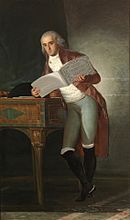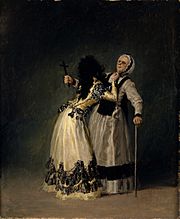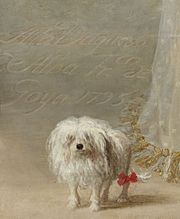The White Duchess facts for kids
Quick facts for kids The White Duchess |
|
|---|---|
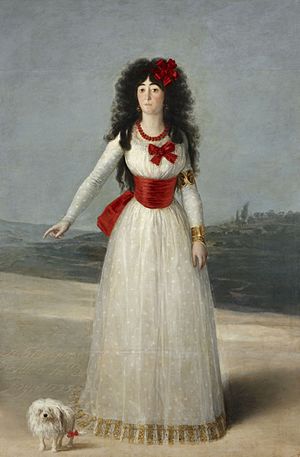 |
|
| Artist | Francisco Goya |
| Year | 1795 |
| Medium | Oil on canvas |
| Dimensions | 192 cm × 128 cm (76 in × 50 in) |
| Location | Collection of the Duke of Alba |
The White Duchess is a large painting created in 1795 by the famous Spanish artist Francisco Goya. It is an oil painting on canvas, measuring 192 by 128 centimeters. This artwork shows María Cayetana de Silva, 13th Duchess of Alba. Today, you can find it in the collection of the House of Alba at the Liria Palace in Madrid, Spain.
Goya painted several portraits of the Duchess of Alba around this time. This painting is often compared to another one, the Black Duchess. The Black Duchess was painted two years later, after her husband, José Álvarez de Toledo, passed away. Both the Duke and Duchess were important and respected people in the Spanish Court during the 1790s. Goya first mentioned this painting in a letter to his friend Martín Zapater in August 1794. He wrote that he had been asked to paint life-sized portraits of both the Duke and Duchess of Alba.
What the Painting Shows
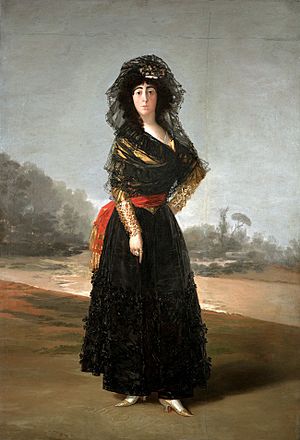
The painting uses colors like white, red, blue, and brown. However, the main colors are red and white, with black for her dark, curly hair.
María Cayetana de Silva was 33 years old when Goya painted her. She had recently recovered from being sick for a long time. Goya painted her in a way that shows her as a beautiful, smart, and interesting woman. She stands in a graceful pose, looking straight at you with a strong gaze. She wears a long, flowing white dress in a French style. This dress is more elegant than the Maja style she wears in the 1797 painting. The dress is made of white muslin fabric with gold embroidery. A small dog, a bichon frise, stands next to her. The dog also has a red ribbon on one of its back legs.
Her left arm has gold jewelry on her wrist and above her elbow. With her right hand, she points to something written on the ground. This writing includes Goya's signature, the year 1795, and the words "A la duquesa de Alba Fr. de Goya 1795." This means "To the Duchess of Alba, Fr. Goya 1795."
The style of her dress is almost Neoclassical. This style might have been influenced by English artists like Thomas Gainsborough, William Hogarth, George Romney, and Joshua Reynolds. Goya probably saw their work through black-and-white copies.
This portrait is quite formal. Showing the Duchess outdoors suggests her wealth, as it hints at her land ownership. Because she was so respected and known for her strong personality, many believe she had a big say in how she was painted. Some art experts have wondered if Goya and the Duchess had a romantic relationship, but there is no proof of this. Others argue that because she was so beautiful, rich, and independent, she might not have been interested in Goya, who was older and not well. Both the "White Duchess" and the "Black Duchess" paintings were very important to Goya. He kept the "Black Duchess" painting for at least 15 years after he finished it.
More Paintings by Goya
See also
- List of works by Francisco Goya
- In Spanish: La duquesa de Alba de blanco para niños
Sources
- Connell, Evan S. Francisco Goya: A Life. New York: Counterpoint, 2004. ISBN: 1-58243-307-0
- Forty, Sandra. 'Francisco De Goya. TAJ, 2014. ASIN B00USAESNM
- Hughes, Robert. Goya. New York: Alfred A. Knopf, 2004. ISBN: 978-0-394-58028-9
- Morales y Marín, José Luis. Goya: a catalogue of his paintings. Real Academia de Nobles y Bellas Artes de San Luis, 1997
- Tomlinston, Janis. Francisco Goya y Lucientes. Phaidon Press, 1994. ISBN: 978-0-7148-2912-8


